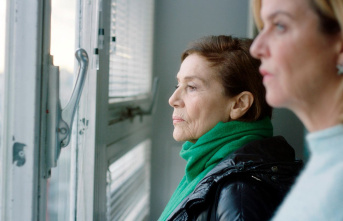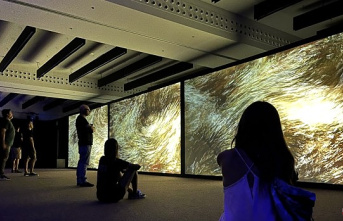A small painting has traveled the 6,000 kilometers that separate Madrid from Washington to be hung in what is, since June 15, the first exhibition of what will be the National Museum of the American Latino in Washington. Among all the points of union of the shared legacy, and of the Spanish participation in the North American Hispanic community, 'De español y negra, mulata' stands out, painted at the end of the 17th century in Mexico within the genre of 'casta painting'. This genre was a fashion in the Viceroyalty of New Spain, family portraits that represented the fruit of relations between whites, natives and Africans in which the population was classified in an orderly manner and according to origin.
It has been loaned by the Spanish Museum of America.
In the seminal exhibition 'Present! A US Latino Story' the managers of the museum want to bring together, as a synthesis, what they consider key concepts, moments and biographies of the historical and cultural legacy of Latinos in the US The Spanish presence is highlighted at two separate points in that history: the legacy of colonization and slavery and the war in Cuba. For the curator of the exhibition, Ranald Woodaman, the reason is "to show that colonization was not really a benign process, but had to do with, in principle, an exploitation of natural and human resources." Woodaman explains that this new exhibition stems from a survey conducted among visitors to the Museum of American History, who said they were unaware of more elements of the colonial past apart from the Anglo-Saxons.
At the moment the National Museum of the American Latino is born in a small gallery of about 420 square meters inside the National Museum of American History, since it has recently been authorized by the Capitol, in December 2020. The museum's managers believe that it will still take a decade to have its building, which at the moment is not known if it will be on the famous National Mall, a national park on a gigantic esplanade in the heart of Washington, flanked by the Capitol, the White House and the monuments to Lincoln and Jefferson. At the moment it already has a management team, which is also seeking financing for its construction and acquisition of historical and artistic objects.
The director of the museum, Jorge Zamanillo, assures that it will reflect the Latino community understood as "a very diverse community, which is made up of many different nationalities that live here in the United States, with things in common such as culture, art, music and also the story of how we got here and the efforts to be independent". Asked about the contribution of Spanish immigrants to the US, Zamanillo states: "The museum is more about Latinos in the US, the person who lives here... How Latinos have lived here in the US, what is What we Latino cultures have in common here in the US, not outside the US».
In 2020, in the midst of a wave of racial protest over the police killing of George Floyd, protesters shot down and painted not only statues connected to the colonial or slave past, such as those of Christopher Columbus or the conqueror Juan de Oñate, but also of Miguel de Cervantes and Don Quixote. Asked about these cases, and the influence of authors such as Cervantes in American literature, Zamanillo affirms that in future exhibitions the museum will also try to dismantle myths. "A museum can explain these connections and stories because there is a lot of ignorance, like if a person has a statue and because he is Spanish he is believed to be a bad person," he says.
For now, this exhibition does feature prominently the different waves of Latin American migration to the US, including life on the border, the Cuban rafter crisis, and the Puerto Rican lifestyle in New York. There are on display everything from valuable altarpieces such as the Santo Niño de Atocha, painted in Santa Fe in the 19th century, to an original dress by the Venezuelan Carolina Herrera. The visitor even finds one of the rafts used to flee Cuba in the 1990s, which is striking for its smallness. However, what attracted the most visitors was a stunning rumbero dress by Celia Cruz decorated with the Cuban flag.
Although the Spanish empire participated little in the slave trade due to its limited presence in Africa, it was an indispensable client of those who lived from it, especially Great Britain, and in fact it was, together with Brazil, one of the last Atlantic powers to prohibit the slavery as such, deeply rooted, especially in Puerto Rico and Cuba. That is the reality reflected and highlighted in the exhibition 'Present! A US Latino History'.
In this exhibition it is stated that "Spanish colonization turned the Spanish and other Europeans of the Catholic religion into a privileged minority in places where there were a majority of black, indigenous and mestizo communities". He adds that "it may be impossible to establish how many millions of people died due to new diseases and the traumas of colonization."
The exhibition as such reflects in the section dedicated to the war in Cuba the exchange of one power for another, when “US imperialism” bursts in, with “the seizure of the Philippines, Hawaii, Puerto Rico and Cuba by the US. ». It also refers to the Monroe Doctrine, with which Washington attributed the rest of the American continent as its own territory of influence, in which it could interfere.
According to Eduardo Díaz, deputy director of the museum, this first exhibition «tries to explain the depth of the contributions of our community in, literally, creating this country of the United States and impacting its national culture. The history that we have in what is now called the United States is very long. So he made us make very difficult decisions. What's left? What is not left? The good thing is that there will be other exhibitions before the opening of the new museum and we will have the opportunity to tell more.
For Díaz, this exhibition "is about the Latin American community, not the Latin American community, nor the Spanish community." “We are 60 million people in this country with a long history and a rich culture. So it is about that experience, even if we do have pieces from Spain », she adds.












